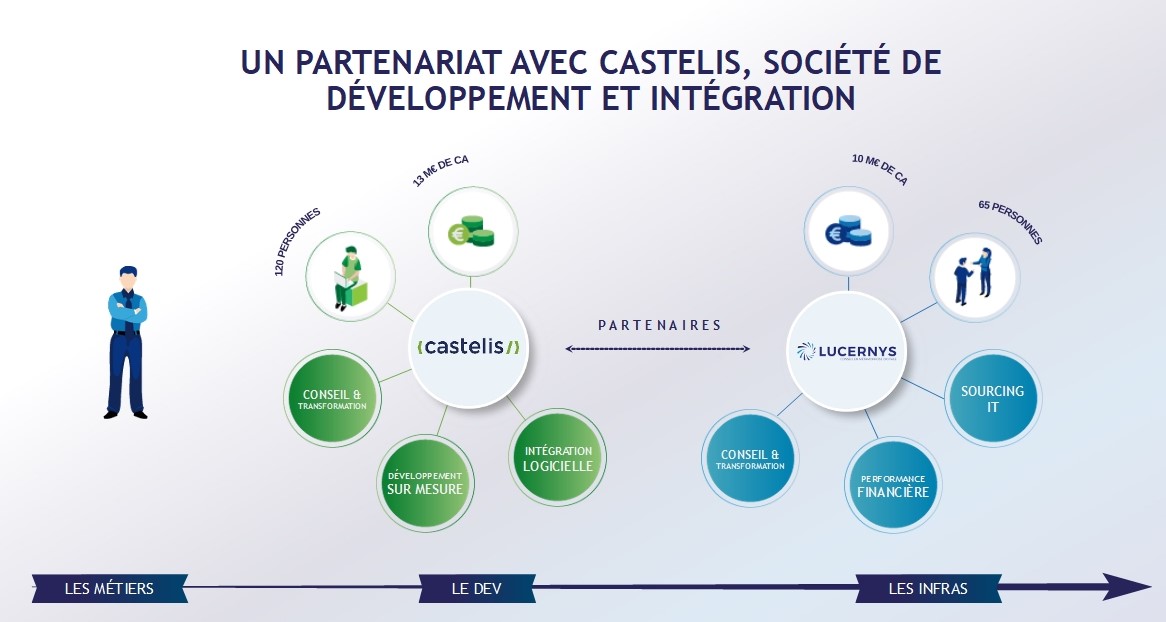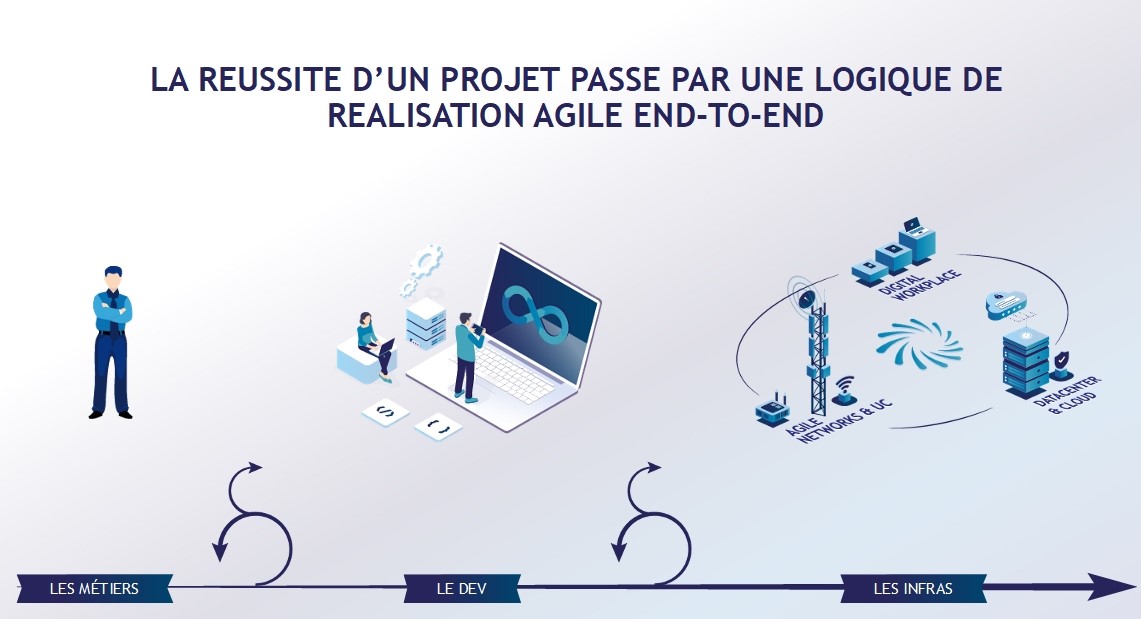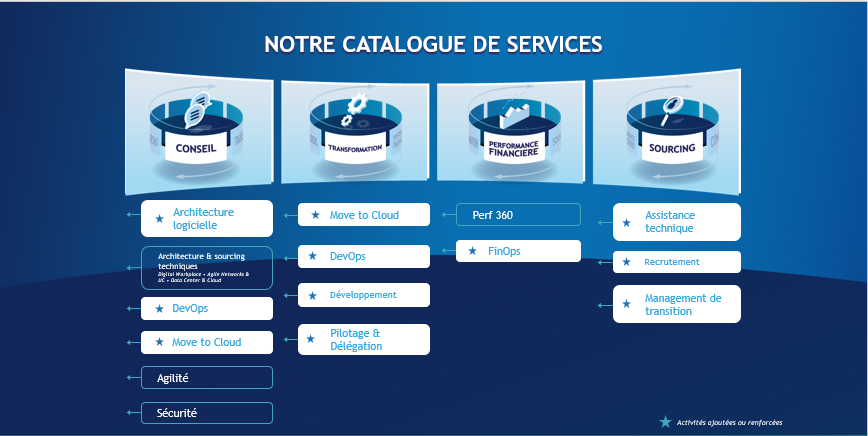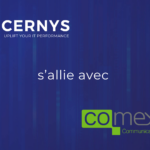Historically present in consulting, Lucernys creates La Tech Agency a business unit dedicated to Application Delivery, DevOps and Cloud. This new BU, the result of a joint venture with Castelis, provides companies with an end-to-end offer and supports them from consulting to the concrete implementation of their transformation projects. A look at this major evolution with Bernard Schmitt and Stéphane Woelffel, founders of Lucernys and Castelis.
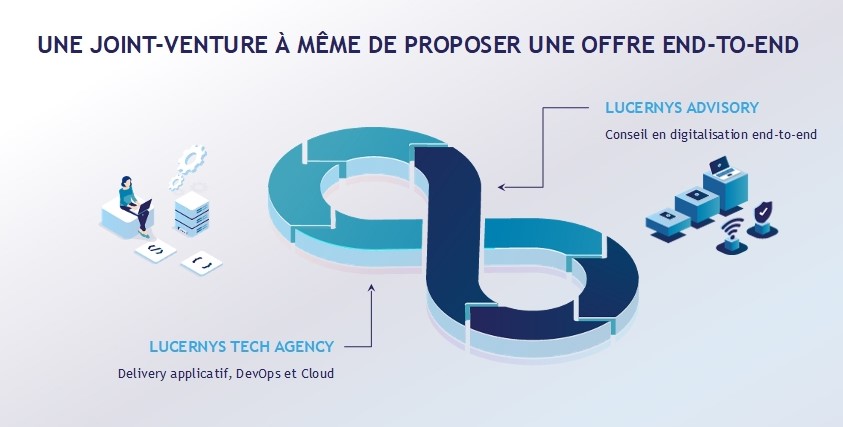
How would you define Lucernys’ positioning today?
Bernard Schmitt: For more than 20 years, our business has consisted of accompanying our clients in their digital metamorphosis by helping them align their IS and their practices with the requirements of the 3 pillars that underlie it: data, ATAWADAC, agility. We work in three main areas: the infrastructure – that we contribute every day to make more “ATAWADAC” and agile – theIT organization that we agilize in coherence with the company’s, and finally, control of the data through our Big Data and IoT offerings inherited from Telecom Expense Management and more generally from FinOps.
Today, we are taking a step forward by choosing to integrate the application brick into the spectrum of our interventions. This development will include a joint venture with Castelis. This step allows Lucernys to enter a new dimension while offering a complete support to our customers, from consulting to the concrete implementation of their transformation.

Bernard Schmitt, President of Lucernys, wanted to integrate Castelis’ application expertise.
Bernard Schmitt: For more than 20 years, our business has consisted of accompanying our clients in their digital metamorphosis by helping them align their IS and their practices with the requirements of the 3 pillars that underlie it: data, ATAWADAC, agility. We work in three main areas: the infrastructure – that we contribute every day to make more “ATAWADAC” and agile – , theIT organization that we agilize in coherence with the company’s, and finally, control of the data through our Big Data and IoT offers inherited from Telecom Expense Management and more generally from FinOps.
Today, we are taking a step forward by choosing to integrate the application brick into the spectrum of our interventions. This evolution includes a merger with Castelis in the form of a joint venture. This step allows Lucernys to enter a new dimension while offering a complete support to our customers, from consulting to the concrete implementation of their transformation.
How did this joint venture project come about?
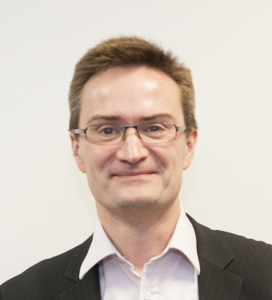
For Stéphane Woelffel, President of Castelis, Lucernys brings an essential consulting dimension.
Stéphane Woelffel : with Bernard Schmitt we know each other since 1993. Each of us followed our own professional path but we regularly crossed paths with the idea of doing things together. Today, the opportunity has become a reality.
Lucernys is very much focused on consulting in infrastructure and production organizations. On our side, we also have an infrastructure dimension but more specifically in project management and in the digital world. That is, everything that is Cloud, hosting and website operations. But historically we come from the world of management software development, more back-office, with an evolution over our 20 years of existence leading us more and more towards front-end solutions.
So there was a real complementarity between us.
On the Lucernys side, what made you decide to internalize the application part?

As the move to the cloud became application-based, we needed the right skills.
Bernard Schmitt: The main reason why we were led to think about this rapprochement is clearly because of this application aspect, which has tended to take precedence in recent years. The move to the cloud is eminently applicative. We therefore needed Castelis’ application expertise to carry out projects of this type.

Lucernys brings us the organizational vision, the cloud migration strategy.
Stéphane Woelffel: You have to understand that when you want to migrate infrastructures to the Cloud, very often you have to go back to the application layer to make it compatible with Cloud infrastructures. We can also do “lift and shift” migration when it is possible, but in this case, we lose the interest of the Cloud because we reproduce on Cloud infrastructures techniques and organizations that are planned for on-premises, therefore with a notion of machine, etc. However, in the Cloud, the notion of a machine will gradually disappear and we will move to services, PaaS, and even Serverless. That is, thinking about applications in terms of making them more APIsable, making them addressable through layers of APIs. It’s a bit like the Holy Grail. Obviously, when we talk about move to cloud, it’s a mix of all these. In other words, there are applications that we will migrate as they are with ROI issues, and others that we will have to redesign. And then there is the whole link between all these applications that needs to be reviewed as well. These are very complex projects with a mix of networks, code, infrastructure, etc.
That’s why it’s interesting to work with Lucernys, which has a very good vision of the consulting, organization, and cloud migration strategy. While we – Castelis – know how to operate this type of migration by working on the applications to make them cloud-compatible.
How do you position the company in this joint project?

When implementing DevOps, there is a high risk of being at the end of the chain.
Bernard Schmitt: Infrastructure is increasingly driven by code. When you’re not in the code, it’s hard to take projects in the right direction. It is easy to become the last wheel of the carriage. To effectively handle a cloud evolution project – and even a cloud build – you have to approach it through code. And so you have to have application skills.
It’s the same thing with DevOps: when it’s implemented in organizations, it often comes from development as well. So if you don’t have the skill, you often find yourself at the end of the line. You are not the initiator of the implementation of a DevOps chain; you are not the initiator of the design and realization of a cloud infrastructure; and you are even less the initiator of a move to the cloud since it is, once again, application based.
Based on this observation, and through the experiences we had with Castelis, we decided that this application component should now be part of Lucernys’ business. We needed to integrate it more than just through a partnership, as we had been doing until now. This joint venture project formalizes our strategic direction, but also a strong trend in IT.
On the other hand, if we do offer this advice around the cloud, move to cloud and DevOps, it is as a project manager. While Castelis acts as project manager. That is, they implement DevOps, build cloud platforms and move to the cloud by taking full advantage of their application expertise. Lucernys, does manage Build projects on these themes, but not as a prime contractor.
What will be the identity of this new offer and its originality on the market?
Bernard Schmitt: This approach will be housed within a new entity called “La Tech Agency“. Upstream consulting is offered by Lucernys while the implementation of DevOps, move to cloud or simply cloud infrastructure will be handled by the Tech Agency, a Lucernys-Castelis joint venture.
Its originality? It is an end-to-end digitalization offer for the company’s businesses. In general, the business needs functionality and what’s behind it is irrelevant. Its demand is for applications that fulfill these functionalities and that we will design and produce in the most agile way possible. Both through agile methods, but also through agile software factories – DevOps – and on agile platforms, i.e. Cloud platforms. So we really do provide an end-to-end response to the needs that our customers may have. And that’s not so common. Today, there are actors who are more infras, others who are more dev. Those who make the whole are rarer.

Our new offer is firmly based on business needs.
Stéphane Woelffel: Indeed, we must insist on the fact that we start from the need. If we refer to the organization of our offers – our five pillars – they are presented in the form of business needs. We talk about financial ERP, we talk about CRM, we talk about marketing, customer experience, etc. So we really start with the needs of the business lines in the company. Then we go end-to-end to the infrastructure and to running the applications.
Can your association also provide an answer to the Shadow IT phenomenon?
Stéphane Woelffel: Indeed, thanks to this new global 360 vision we are improving this point. The IT department takes over what can be done in marketing, sales, or other departments that sometimes tend to implement their own tools. Bringing agility and a business and development dimension to the consulting component, really starting from the need, also helps to avoid the IT Shadow and to ensure that the IT department keeps control over the applications and infrastructures.
Bernard Schmitt: Absolutely. We are first and foremost IT players. And this ability to discuss with the business and to be in an end-to-end logic, effectively allows them to be oriented towards IT solutions and not shadow IT solutions that may be proposed by web agencies, for example.
On the Lucernys side, FinOps is also a key competency. How will your synergy benefit?
Bernard Schmitt: Indeed, this FinOps brick allows us to really go to the end of the chain by putting Cloud expenses under control. This has existed at Lucernys for a long time, from the business need to its realization, and even its exploitation managed by Castelis. The Tech Agency is not intended to do operations or outsourcing – which remains the domain of Castelis – but the FinOps part is the responsibility of Lucernys and is also part of the offer. It brings an additional brick to the Castelis offer.
Stéphane Woelffel: Clearly. We run the solutions, making sure they work well. But beyond the operational side of things, costs are analyzed and controlled via the Lucernys FinOps brick, which perfectly complements our offering.
Lucernys also has an important IT sourcing activity. Is this something that will find opportunities in your association?
Stéphane Woelffel: Clearly, this is one of the objectives too. I would say that IT sourcing is almost a consequence. Indeed, as we are experts in many fields, we are often called upon on an ad hoc basis, because Cloud migration and DevOps implementation projects are rather ad hoc. This is a project. As for the Run part, it can be either outsourced – in this case it is carried out by Castelis and is financially controlled by Lucernys via FinOps – or internalized at the client’s site. And in this case, we also have this ability to provide resources for the Run.
Bernard Schmitt: Indeed. Finally, we are in the business of consulting, transformation and therefore necessarily sourcing profiles in the long term. As we transform, most of the time, the people who join the teams during the project, stay beyond. It also completes the offer of Lucernys which had a sourcing offer rather oriented infrastructure: today the infrastructure profiles are opened to dev profiles.

